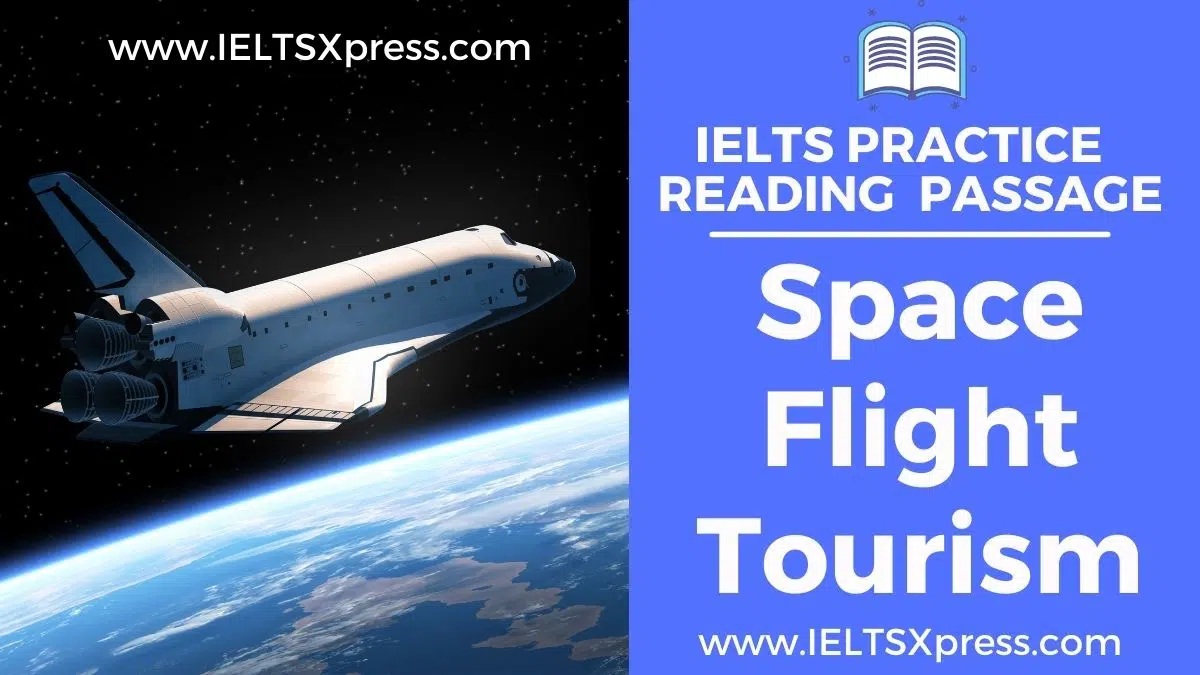Space Flight Tourism IELTS Reading Passage with Answers
Reading Passage 2
You should spend about 20 minutes on Questions 14-26 which are based on Reading Passage 2 below.
Space Flight Tourism
Falcon 1’s successful launch on 28th of September was an outstanding achievement for the fledgeling space tourism industry. When a rocket made by Space X in Hawthorne, California, reached an orbit of 500 kilometres from the Earth, it became possible for privately developed rocket too.
Two days after the launch, Virgin Galactic started a business with the US National Oceanic and Atmospheric Administration which will be accepted by US scientists as a way of researching climate change using a spacecraft.
No doubt the civilian space flight industry is an exciting area and this was apparent at the International Aeronautical Congress in Glasgow last month. It displayed slick promotional videos, and models of the “Nearly Ready” spacecraft in orbit to the people who would be investing money in the project.
However, in spite of increasing confidence, it is also necessary to be cautious: can a civilian spacecraft be safe like holiday airlines? Gerardine Goh, a lawyer at DLR, the German Aerospace Centre in Bonn and a member of Germany’s delegation to the UN’s Office of Outer Space Affairs reported that as it is not global, there need to be enforceable regulations in place to guarantee the safety of a civilian spacecraft. She said, “Ships should be equipped to be seaworthy, aircraft should be equipped to be airworthy but there is no legislation in place to ensure that a spacecraft is spaceworthy.”
At the International Association for the Advancement of Space Safety, Goh is planning to press the UN to force civilian space operators to warrant which spacecraft are designed and built to minimum safety standards. She says, “Mass commercial space flight does not currently have international safety regulations.” and “We deeply need a UN treaty which offers us this.”
One way companies are planning to transport tourists into space is with a “mother ship”, an aircraft which carries a rocket at an altitude of 16 kilometres before launching it, says Goh. “But with launching the aircraft, the ICAO’s air safety standards only apply to the mother ship and the rocket capsule until they are separated. After that, we do not have any safety standards for the capsule itself. It is a critical problem.”
From 16 kilometres to the Karman line, the point of 100 kilometres up where space is considered to start, the rocket will be travelling within a legal vacuum. Here, lawyers cannot agree on whether it is a plane or a rocket. Some insist that if you are in a well-equipped functioning rocket, more strict safety measures should try to be incorporated into the spaceship’s design.
The other aspects of the UN’s 1967 treaty for outer space exploration may be discussed again if civilian space flight turns out to be successful. For example, countries must consider how to rescue and repatriate astronauts crashing or landing in their land. Also, governments have to decide if the money generated by the space flight industry will be enough to cover the cost of rescuing space tourists.
Civilian space flight companies are very aware of the risks in this field as they have already had the experience of dealing with a tragedy. Unfortunately, three engineers were killed and another three were severely injured in 2007, when nitrous oxide rocket fuel suddenly exploded during fuel flow tests at a Scaled Composites facility in Mojave, California. The company is establishing WhiteKnightTwo, a carrier aircraft and SpaceShip Two, a six-seater rocket for Virgin Galactic. The facility was regulated by California’s health and safety regulator, and it has now modified its technology to decrease the risks.
However, space flight’s dangers are far from just fuel issues. According to Laurent Gathier of Dassault Aviation developing the VSH of a rocketpowered sub-orbital tourist space plane, other critical safety factors are with depressurization risks, passengers close to the engine and the activities of flight trajectories including cosmic ray shielding.
Civilian space companies should incorporate the safety features into their designs. For instance, the VSH will equip an ejector seat for all tourists and staff. It is a device for bailing out of the spacecraft with a default of 40,000 feet (12 kilometres).
Goh’s vision is essentially against the Federal Aviation Administration Office of Commercial Space Transportation (AST) and does not have any schemes to regulate civilian space flight safety until 2012. The Commercial Space Launch Amendments Act of 2004 mentions that George Nield as AST chief said, the civilian space flight regulation must not “stifle” the developing technologies with inconvenient rules.
Before launching, a hands-off approach to civilian space flight could be quite risky. Goh said, “A lack of safety standards and a lot of operational burdens will leave a commercial space flight in the dangerous activity categories in terms of the insurance.” It means insurance costs will be very high. Critics who are developing safety standards also insist that the “at-your-own-risk” mentality that is applied to risky sports like scuba-diving should also be applied to civilian space flight.
Questions 14-20
Complete the summary.
Choose NO MORE THAN THREE WORDS from the passage for each answer.
Write your answers in boxes 14-20 on your answer sheet.
On 28 September the emerging space tourism industry was enormous. In Hawthorne, California, a rocket was erected by 14 _________. Climate change was monitored by 15 _________ in US National Oceanic and Atmospheric Administration using its spacecraft. In Glasgow, at the International Aeronautical meeting, it is apparent that civilian space flight industry is growing, as it showed the 16 _________. spacecraft which promised sub-orbital flights. Although developing confirmation, non-regulation is clear to guarantee 17 __________. A method for space business is cooperating with a 18 _________. conveyable at 16 kilometres in the skies. From 16 kilometres to 100 kilometres’ travelling may be available, but lawyers definitely cannot agree with whether it is a 19 _________. or a rocket. 20 _________need to be revisited if civilian space flight proves successful.
Questions 21-26
Complete each sentence with the correct ending A-I below.
Write the correct letter A-I in boxes 21-26 on your answer sheet.
21 Civilian space flight companies
22 Laurent Gathier
23 VSH devised for a safety
24 AST chief George Nield
25 Insurance costs
26 Critics
A assisted some minimum safety standards may prevent that.
B emphasised a civilian space flight must not be under a severe regulation for technical advancement.
C hardly need a reminder of the danger when considering past experiences.
D will protect a commercial space flight.
E try to develop a module of safety regulations applied to civilian space flight.
F made up for an ejector seat for tourists and the crew in case of a craft emergency in the skies.
G indicated the main safety problems were with passengers’ proximity to the powerful engine.
H believed that scuba-diving should be applied to civilian space flight.
I kept costs stratospheric.
Space Flight Tourism IELTS Reading Passage Answers
Practice with Expert IELTS Tutors Online
Apply Code "IELTSXPRESS20" To Get 20% off on IELTS Mock Test
14. Space X
15. US scientists
16. Nearly Ready
17. safety
18. mother ship
19. plane
20. UN’s 1967 treaty
21. C
22. G
23. F
24. B
25. I
26. E
Also Check: Keep a Watchful Eye on the Bridges IELTS Reading




